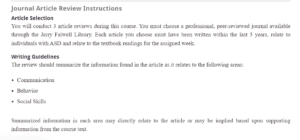Occupational Therapy
Occupational therapy is among the most widely used services that ASD children receive. The article by Welch and Polatajko (2016) presented an argument (that is literature-based) for the utilization of applied behavior analysis (ABA) in practicing occupational therapy. In this regard, the authors gave a description of the relevant literature in determining the extent of ABA use, considerations on why ABA is not utilized and consequently made a strong case for the compatibility between occupational therapy and ABA principles. The authors also showed that these two could be successful when utilized synergistically.
Do you want an entirely new and genuine copy of “Occupational Therapy”? Feel free to contact us.
Communication
Sensory integration is an intervention that is therapy-based and which is often implemented by occupational therapists. An example is when an occupational therapist designs and implements an individual program for an ASD child (Boutot, 2017). The authors in this article pointed out that ABA literature, in discussing occupational therapy, seems to focus more on sensory integration approaches used by occupational therapists. This literature illustrates a perception of ABA literature that touches on sensory integration in occupational therapy as conflicted. On the other hand, some ABA therapists have reported using it in their practice, sensory integration approaches. The wider literature also highlights this tension, which portrays sensory integration as an alternative or complementary medicine.
Behavior
The authors assert that the application of ABA principles can enhance intervention when using occupational therapy. This is based on the effectiveness of ABA in addressing several occupational therapy areas. Specifically, these ABA-based intervention strategies are effective in peer engagement, play and leisure, self-care, promotion of work skills, and minimizing sensory behavior disruption. These are the same areas that occupational therapists serve when treating persons with ASD. The occupational therapy practice can augment the ABA outcomes as the latter offers features that are not typical of ABA. For example, occupational therapists put a lot of value on child playfulness and can build an experience that is rich in play while simultaneously working on play component skills.
Additionally, real-life contexts are used in occupational therapy as well as the use of techniques that are naturalistic. Occupational therapy practice takes a holistic perspective and, more so, the skills of the practitioners in analyzing the behavior of ASD children and multi-level performance. Boutot (2017) points out that although modern-day ABA considers a person’s desires, feelings, and thoughts, ABA practitioners are trained in a broader analysis in addressing and assessing performance components such as motor issues, social skills, sensory differences, and transitions. Further, in the article, the authors added that occupational therapists could address the difficulties of persons with sensory processing, executive functioning, physiological components, and self-regulation, such as strength and praxis. Examples include reinforcer selection based on understanding tactile responses and running an analysis of performance based on understanding reflex patterns.
Social Skills
The literature analyzed by the authors emphasized the consideration of the cultural and social context in both ABA and occupational therapy. ABA and occupational therapy literature identify that collaborative decision-making is important. For example, both involve planning goals and interventions related to clients, collaborating in target goals selection, identification of generalized strategies, and selection of reinforcers. So while developing skills, both ABA and occupational therapists emphasize that the goals set are in line with the child’s social and cultural context.
Conclusion
Examination of the literature showed that approaches in occupational therapy trends as regards autism intervention diverge from the field’s main approaches. The literature on ABA suggests that there are many ABA misperceptions asserting that ABA is not centered on the client. This kind of misperception of ABA is why it is absent in the practice and literature of occupational therapy. However, because strong evidence supports ABA, it can potentially improve occupational therapy outcomes. Additionally, analysis skills used in occupational therapy make them suitable for the adaptation of ABA principles.
Similar Post: Financial Disclosure
References
Boutot, E. A. (2017). Autism spectrum disorders: Foundations, characteristics, and effective strategies – With access (2nd ed.). Upper Saddle River, NJ: Pearso
Welch, C. D., & Polatajko, H. J. (2016). Applied behavior analysis, autism, and occupational therapy: a search for understanding. American Journal of Occupational Therapy, 70(4), 7004360020p1-7004360020p5.
ORDER A PLAGIARISM-FREE PAPER HERE
We’ll write everything from scratch
Question
Journal Article Review Instructions
Article Selection

Occupational Therapy
You will conduct 3 article reviews during this course. You must choose a professional, peer-reviewed journal available through the Jerry Falwell Library. Each article you choose must have been written within the last 5 years, relate to individuals with ASD and relate to the textbook readings for the assigned week.
Writing Guidelines
The review should summarize the information found in the article as it relates to the following areas:
- Communication
- Behavior
- Social Skills
Summarized information in each area may directly relate to the article or may be implied based upon supporting information from the course text.
Each review must be 2 pages (excluding title and reference pages) and follow current APA format (including in-text citations and headings). Each article should include at least 2 sources (course text and selected article); however, additional references are encouraged. In-text citations should be included for each of the 3 specified areas and references provide at the end of the review. The review should include an Introductory and Closing paragraph as well as a paragraph for each of the 3 required headings (communication, behavior, social skills).
- The introductory paragraph should provide a brief overall summary for the article and/or study conducted.
- The paragraphs for each of the 3 headings should address information specific from the article regarding the respective heading. Clear links should be made between the article and assigned weekly readings.
- The closing paragraph should include a clear summary of the main points of the article and implications for supporting individuals with ASD.
Submit each assignment via Bb SafeAssign by 11:59 p.m. (ET) on Monday of the assigned module/week.

